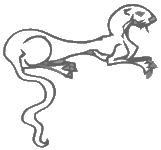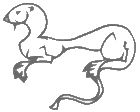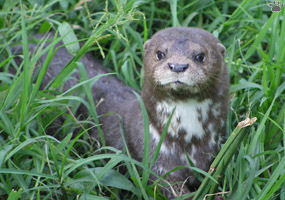 |
 |
 |
 |
 |
 |
 |
 |



Spotted Necked Otter
Size:
From nose to tail the Spotted Necked Otter is 95 to 117 cm
long. The head and body is 62 to 72 cm long, and the tail
is 33 to 46 cm long. It weighs from 10 to 20 lbs, and males
are generally much larger than females.
Ecology Habitat: Streams, lakes, and marshes. They avoid turbulent waters, and prefer deep, calm water. Range/Distribution: The spotted necked Otter lives in sub- Saharan Africa in most of the river systems. They are particularly abundant in Lake Victoria and Lake Tanganyika
Conservation Status: Least concern
Behavior Life Cycle: The spotted necked otter lives in a holt in the river bank, the entrance to which is generally underwater. They breed seasonally between September and December. They have a 60 to 65 day gestation period, and usually have one to three pups. The males do not stay to help raise the pups, but it has been reported that in some instances the male returns when the cubs are five months old to help feed the pups. The pups are born grey with cream colored spots. They are swimming at about eight weeks old, and weaned between twelve and sixteen weeks. The pups stay with their mother for about a year. Social: Spotted necked otters are usually diurnal, but are sometimes nocturnal. Their territories encompass up to two miles of shoreline, smaller than those of most otters. The males overlap their territories with one or more females. They are not very protective of their territories, often forming social and hunting groups of anywhere from five to twenty members, but live alone or in small family groups. Their social habits seem to vary between regions.Vocalizations: Females make bird-like metallic chirps to communicate with their young. They make similar chirping sounds to communicate with each other, and a sharp "F" sound as an alarm call when there is danger. Individual: These otters spend more time in the water than other freshwater species, almost never leaving the water's edge. Resting sites, holts, latrines, and breeding areas are all right next to the water, and they are not very agile on land. Spotted necked otters do not venture into estuaries or the ocean. Like other otters, the spotted necked otter is very playful throughout its life.
speckle-throated otter spot-necked otter Spanish: Nutria de cuello manchado Other scientific name: Hydricits Malculiollis Subspecies:
africanfauna
spottedneckedotter page , lioncrusher's
spottednecked otter page
|
OtterQuest (c) 1999-current. Contact OtterQuest.
A few images on this web site have been borrowed from other sources, I credit them in the Links/Resource Page. Some may not yet be credited, if you know the source of an uncrdited photograph, please e-mail me with the information. Thank you. Dana


 Identification
Identification


